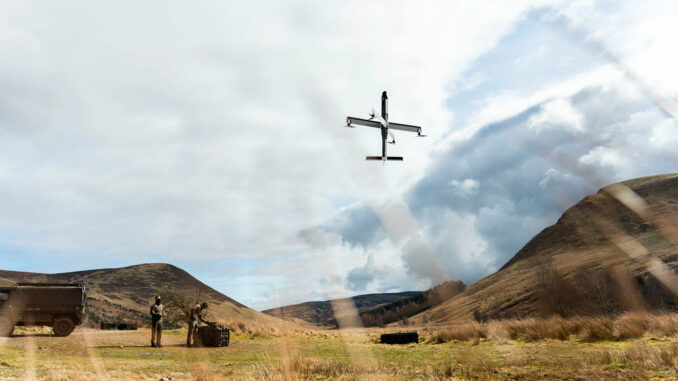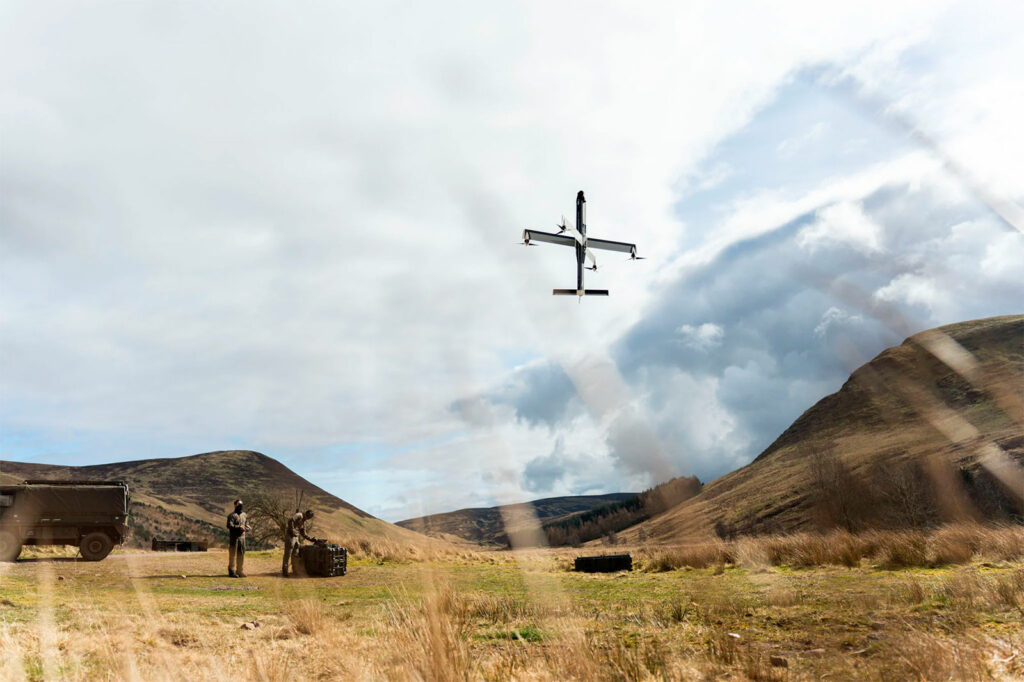
The STARK OWE-V drone, equipped with advanced AI, offers a range of 100 km and increased resistance to electronic warfare.
On April 14, 2025, the German company STARK presented the OWE-V drone, a loitering munition with vertical take-off and landing (VTOL) designed in collaboration with the Ukrainian armed forces. With a range of 100 km and an artificial intelligence-assisted targeting system, the OWE-V is optimized to operate in environments subject to electromagnetic interference. Its modular design allows for software and hardware updates, offering increased adaptability on the battlefield. The drone can be recalled in flight, thus reducing collateral damage and operational costs. This innovation is part of a broader strategy to strengthen European defense capabilities against emerging threats.
Technical design and operational capabilities of the OWE-V drone
The OWE-V drone represents a significant advance in the field of loitering munitions. With a total take-off weight of approximately 31 kg, including a 5 kg warhead, it is capable of targeting armored vehicles, including tanks. Its electric propulsion gives it acoustic discretion, essential for reconnaissance and attack missions in urban environments.
Vertical take-off and landing (VTOL) capability allows the OWE-V to operate without the need for traditional infrastructure such as airstrips or launch catapults. This feature offers increased operational flexibility, particularly in confined or degraded environments.
The artificial intelligence-assisted navigation system allows the drone to determine its position and navigate independently of satellite signals, a crucial feature in areas where GPS is jammed or unavailable. In addition, AI-assisted terminal guidance ensures increased accuracy during the final approach to the target, even in the event of a loss of telemetric connection.
The modular design of the OWE-V facilitates the integration of software and hardware updates, enabling rapid adaptation to technological developments and the specific needs of operators. This modularity is essential to maintaining the relevance of the system in the context of constantly evolving electronic warfare.
Resilience in the face of electronic warfare and electromagnetic interference
The OWE-V was specifically designed to operate in contested electromagnetic environments. Field trials in Ukraine have validated its ability to maintain effective communications and control, even in the presence of jamming or electromagnetic interference.
Autonomous navigation assisted by artificial intelligence allows the drone to continue its mission in the event of disruption of communication signals, thus reducing dependence on traditional radio links. This autonomy is enhanced by terminal guidance algorithms capable of compensating for signal loss and maintaining the trajectory to the target.
The in-flight recall capability offers additional tactical flexibility, allowing operators to cancel an ongoing mission if conditions change or if risks of collateral damage are identified. This feature contributes to a more ethical and controlled use of loitering munitions.

Strategic implications for European defense and NATO
The development of OWE-V is part of a broader drive to strengthen European defense capabilities in the face of emerging threats. The war in Ukraine has highlighted the importance of drones in modern conflicts, prompting European countries to invest in similar technologies.
The STARK initiative to produce mass deterrence systems responds to a growing demand for effective and adaptable solutions for European armed forces. The OWE-V’s mass production capacity allows for rapid and large-scale distribution, which is essential to meet urgent operational needs.
Collaboration with the Ukrainian armed forces also offers an opportunity to integrate concrete feedback into the development of the drone, thus ensuring increased operational relevance. This collaborative approach could serve as a model for other partnerships between European industries and allied armed forces.
Consequences for logistics and operator training
The integration of the OWE-V into the armed forces requires the adaptation of logistics structures and training programs. The modularity and ease of deployment of the drone reduce infrastructure requirements, but require specific training for operators.
The ability to recall the drone in flight allows for reusable training missions, thus reducing operational costs and ammunition requirements. This feature also offers increased flexibility for tactical exercises and mission simulations.
System maintenance, facilitated by its modular design, nevertheless requires specific technical skills to ensure software updates and the integration of new modules. Continuous training of technical teams is therefore essential to guarantee the operational availability of the drone.
Prospects for evolution and integration into military doctrines
OWE-V represents a significant step forward in the evolution of military doctrines, integrating cutting-edge technologies to meet contemporary challenges. Its deployment could influence the way armed forces plan and execute reconnaissance, targeting and attack missions.
The ability to pursue targets in contested environments at low logistical cost places the OWE-V in the category of tactical asymmetric systems, capable of counterbalancing the advantage of heavier and more expensive platforms. This type of weapon is playing an increasingly important role in high-intensity conflicts.
In terms of doctrine, the European armed forces could integrate this type of drone into a logic of “tactical air saturation”: the simultaneous sending of multiple inexpensive drones, capable of identifying, targeting, and neutralizing heavier enemy assets (radars, artillery, armored vehicles). This is in line with the trends observed in Ukraine, where the proliferation of loitering munitions has contributed to an erosion of Russia’s conventional ground-to-air defense and electronic warfare systems.
From the point of view of doctrinal integration, several European armies, including the Bundeswehr and the French army, are seeking to develop an operational segment dedicated to tactical and medium-altitude long-endurance (MALE) unmanned aerial systems. The OWE-V modular model could be integrated into these systems via a network warfare approach, with inter-drone communication, dynamic target allocation and real-time data fusion.
Finally, the increasing autonomy offered by embedded algorithms raises ethical and legal questions about the use of autonomous lethal systems. The fact that the drone can be recalled at any time is a key element in its compatibility with current international standards of proportionality and discrimination in the use of armed force.
A milestone in the production of European drones
With the OWE-V, STARK introduces a European tactical drone model adapted to the realities of contemporary electronic warfare, with a modular architecture, advanced on-board AI, and a VTOL mode. It is a relevant tool for precision strike and surveillance doctrines in modern conflicts.
The estimated unit cost of a drone in this class varies between €20,000 and €40,000, depending on the payload and on-board connectivity options. This competitive price, compared to conventional guided munitions or MALE drones, makes it a logical candidate for bulk purchases within the framework of growing European defense budgets.
This innovation comes at a time when the European Union has increased its defense budgets by 13% in 2024, and France, Germany and Poland plan to double their fleets of tactical drones by 2027. STARK’s role in the creation of a European industrial cluster for autonomous drones could therefore rapidly strengthen, as the logic of mass production becomes decisive.
War Wings Daily is an independant magazine.